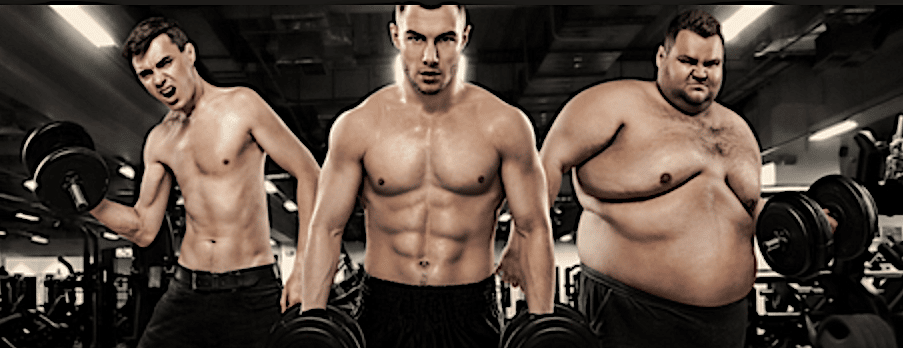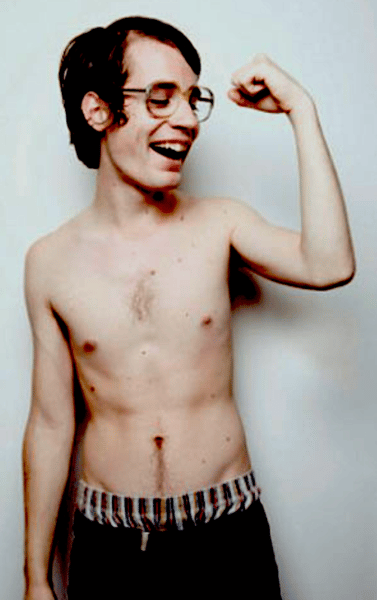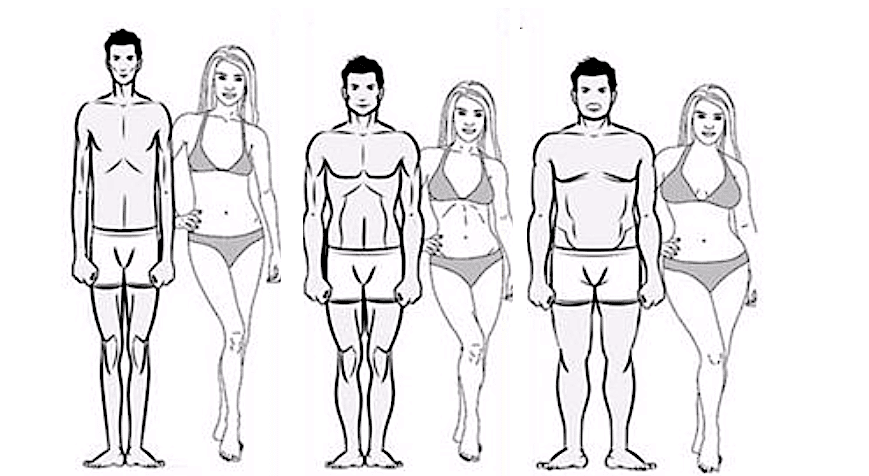The morphotypes
Do you know your body type? Discover the characteristics of the three main types to identify yours, and make your weight training even more effective.
What is a morphotype?
This term is used to designate the type of figure or morphology that an individual (man or woman) has inherited from his or her genetic heritage. If one cannot change one's morphology as such, it is however possible to "sculpt" one's silhouette and to gain muscle through progressive weight training. William Herbert Sheldon has devised a classification of three morphotypes to help define the morphological profile of an individual. Thanks to this method, it is possible to train or eat in a more personalized way.
View on the 3 different human morphotypes:
1. The ectomorphic type
This physical type, with an H-shaped figure, has thin bones, light musculature and an often triangular face. They have a narrow pelvis and shoulders, with long limbs. Without training, it is difficult for him to gain muscle, but he has a natural flexibility. Of nervous temperament, his metabolism is fast and it is not easy for him to gain weight.
His heart rate tends to be high. Its thin joints will need to be strengthened by targeted training, because of their fragility. Often with a small appetite, he may be somewhat thin. Also, to gain weight, he will have to make sure that he ingests a sufficient number of calories. A good distribution of macronutrients on a daily basis (proteins, lipids, carbohydrates) is essential.
Need to know your calories and macros to consume?
Thanks to weight training, the ectomorph will be able to develop a resistant body, with a muscular, dry and aesthetic physique. Without going so far as to opt for an immediate hypercaloric diet. Subjects of this physical type should gradually increase their caloric intake (even if it means eating 6 small meals a day rather than 3).
The emphasis should be on quality proteins (red and white meat, fish, eggs and legumes) and complex carbohydrates (oatmeal, rice, pasta and whole grains). It is preferable that he does not combine meat products with cereals in the same meal. Finally, it will be necessary to change his diet gradually. It will be less difficult for him to dry out but more difficult to gain muscle mass.
2. The endomorphic type
The endomorph can be recognized by its rounded face and its slightly stocky silhouette. With wide hips, their shoulders are rather narrow and their limbs short. Its predisposition to gain weight is due to a slow metabolism and a sometimes difficult digestion. His blood pressure is normal, but he may experience occasional drops in energy.
Without investing in an extreme hypocaloric diet, he must opt for a balanced diet and make sure that his energy expenditure is sufficient to burn the calories ingested. Small meals spread throughout the day will help boost metabolism while preventing weight gain. The ideal diet for an endomorph is made up of lean proteins, green and colourful vegetables, and a small amount of complex carbohydrates. It is important to avoid bad fats and sugars.
Physical exercise, primarily focused on endurance, will develop strength and muscle mass while gradually decreasing body fat. With regular weight training, the endomorph can achieve a very muscular and powerful body. Drying out may take longer to occur in this case, so it is advisable to work on strength training in longer sessions to burn calories as much as possible.
Training in cardiotraining will help him avoid being overweight, without reducing his weight. In case of stagnation, his trainer will plan an exercise program to stimulate hypertrophy to the maximum.
3. The mesomorphic type
The person with a mesomorphic figure usually has an angular or square face and long limbs. The shoulders and torso are wider than the pelvis, forming an athletic "V" shape.
In the female of this type, the shoulders are the same width as the pelvis. The mesomorph's blood pressure is often low and its body fat content is low. Naturally, they have a good amount of muscle. Thanks to its strong bones and joints, it can easily gain muscle mass during training. On the other hand, it will take longer to lose fat.
Its constitution allows it to absorb nutrients efficiently, without accumulating fat mass. This physical type can become very massive with weight training and proper nutrition. He will benefit from developing flexibility in his joints and muscles - hence the importance of planning stretching before each workout.
Regular moderate training is enough to develop sculpted muscles and maintain a normal body fat percentage. However, he must respect the recovery breaks to make good progress. In his diet, it will be good to monitor the intake of carbohydrates to avoid storing excess fat, especially in the abdominal area.
What to do if your body type corresponds to 2 morphotypes?
Very few men and women meet 100% the characteristics of a single body type. It is therefore normal to find points of resemblance with a physical type other than the one that corresponds to your silhouette. As muscle mass is generally greater in men than in women, it is easier for them to recognize their body type.
Women have more body fat, which can - to a certain extent - hide the actual muscle mass. Based on the volume of the hips, ribs and chest, a woman can define her morphological type, as well as identify certain features belonging to another type. It is important to remember that not everything depends on your genes and ethnic origin.
Your physique has also been influenced by your eating habits and lifestyle. For example, a diet high in sugars when you were young may have caused you to develop an endomorphic tendency, just as a diet low in protein may have caused you to develop an ectomorphic tendency as you grew.
To ensure that you choose the type of exercise and diet that suits you, base yourself on the morphological profile that has the most affinity with your figure. While taking into account, in a moderate way, the recommendations (exercises and diet) mentioned for the second morphology, in which you find points of resemblance with your body type.
Is it necessary to take into account its morphology in bodybuilding to progress?
This is not an absolute, but by adapting your weight training to your body type, you put much more chances on your side. The same exercises, the frequency and the duration of the sessions vary from one morphotype to another, because the metabolic needs are different for each individual. For example, if an endomorph needs to work on rather long sets to burn even more fat mass, it is the opposite for an ectomorph.
The latter will benefit from shorter workouts (about 45 minutes) and less cardio training. As for the mesomorph, his body requires a more intensive training. Because of their strength, stamina and muscle mass, this morphotype can combine weight training sessions with sports practice; their rapid recovery is another advantage.
To complete your profile, ask the coach who follows you (if you have a personal trainer) to know what type of muscle fibers you have (slow, intermediate, fast...) in order to target the exercise program that is best suited to you. Anabolism (which builds and renews cellular tissue) and catabolism (which transforms macronutrients into energy) are two aspects of your metabolism that must also be taken into account.
Do you want a complete bodybuilding program to follow?
Conclusion
Identifying your body type will help you to better understand how your metabolism works and to choose the type of exercise and diet that will help your bodybuilding training program progress.
However, with time and age your body type may change.
Moreover, this concept should be taken with caution as it is not based on any scientific evidence and is widely questioned.
Everyone is different and it would be a big mistake to classify oneself in a particular morphotype which would lead to the failure "I am endomorphic it is my nature then I can never be dry" or "I am ectomorphic, I will remain thin and will never take muscle it is my morphology".
These are often excuses for not questioning one's lifestyle, training and eating habits.
Believe me there is no fatality and anyone can transform their own physique by adopting a precise program with a strong motivation. Some people will just need more time but nothing is impossible.
You will find a paragraph on morphotypes in more detail in the fat loss program: PHYSIQUE PRO SHREDZ
Other articles to read :
Captain America's training program
The paleo diet for bodybuilding










2 Comments
good evening julien,
if I understand your article well, there are morphotypes but it is not reliable at 100% because of age and hormonal changes
some coaches offer morphological analysis to adapt to our expectations. What do you think about it?
I think that the notion of morphotype is largely outdated and has no scientific basis. We cannot rely on it to create a personalized program, it must go far beyond that. Those who propose morphological analyses are only selling an additional formula...